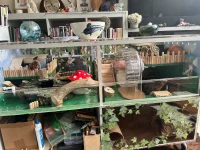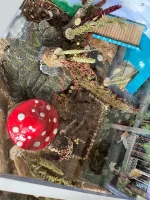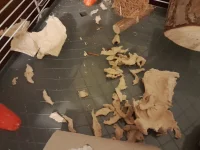- Messages
- 46
- Reaction score
- 62
- Points
- 48
Follow along with the video below to see how to install our site as a web app on your home screen.
Note: This feature may not be available in some browsers.


She can give Blossom a run for her money then who has a love of shredding egg boxes lolDuprasi are actually more closely related to gerbils (they are also known as the fat-tailed gerbil), but in general care is closer to that of a hamster. They are about the size of a dwarf hamster, and just as clumsy, so consideration has to be given to making sure they can’t fall of things. So the cage I planned for a dwarf only needed a couple of tweaks.
They are insectivores, so diet is again hamster or gerbil food supplemented with lots of insects. They also like a bit of fresh food, but as desert animals, not to much.
One big difference is the level of destruction! When I had gerbils, lots of people collected loo rolls for me, as they got through so many. With a dwarf hamster, I was throwing them out. Apparently, these little furballs can beat a gerbil in a loo roll threading competition!

Oh wow. I was amazed at the total lack of of any destruction by Louet and Titch, my previous dwarf. Looks like Blossom really gets stuck in!She can give Blossom a run for her money then who has a love of shredding egg boxes lol
View attachment 10646
Thank youMoth is a sweet little creature. She's luckily found a great home
Thank you. Sometimes being creative can feel like a bit of a curse, you can’t just keep things simple! It took me ages to stick all the moss on. But I think it was worth it. I’m intrigued to see how the destruction affects things. I’m planning out the new cage, but depending on the damage done here, I may have to scale back my plansThat looks amazing! You are very creative and Moth looks very sweet. So Moth will like destroying things then?! Will the set up look rampaged soon then?
We use essential cookies to make this site work, and optional cookies to enhance your experience. Optional cookies include third party cookies from Youtube (which enable embedded Youtube videos to play) and affiliate partners that help support the forum.
